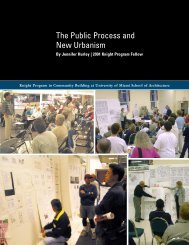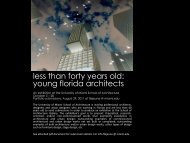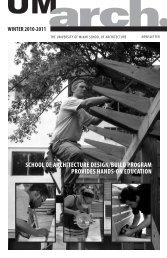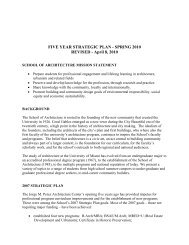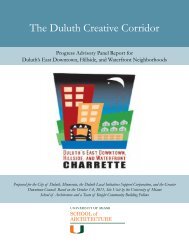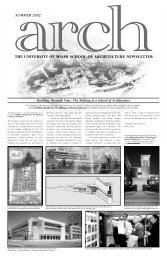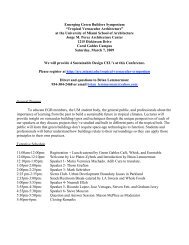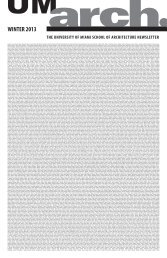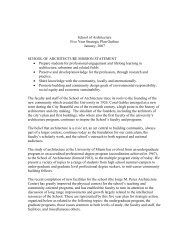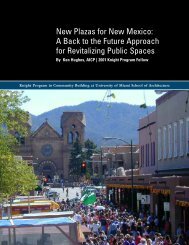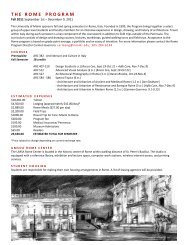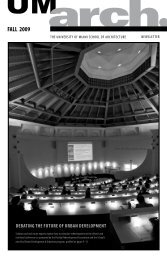Resilience - University of Miami School of Architecture
Resilience - University of Miami School of Architecture
Resilience - University of Miami School of Architecture
Create successful ePaper yourself
Turn your PDF publications into a flip-book with our unique Google optimized e-Paper software.
Virginia Key currently contains the following primary uses:<br />
recreaon<br />
• <strong>Miami</strong> Seaquarium<br />
• <strong>Miami</strong> Marine Stadium<br />
• Virginia Key Beach Park<br />
• Hobie Beach<br />
• Rickenbacker Marina<br />
• Rusty Pelican, Jimbo’s and Bayside Hut restaurants<br />
civic<br />
• <strong>Miami</strong> Dade County Virginia Key Wastewater Treatment<br />
Plant<br />
• Mast Academy High <strong>School</strong><br />
• Municipal land-fill site (closed)<br />
is a recognion <strong>of</strong> the stadium’s cultural value beyond the <strong>Miami</strong> community<br />
(figure 3). The arficial lagoon to the north <strong>of</strong> the stadium separates the recreaonal<br />
zone along the causeway from the natural and infrastructure uses to<br />
the north.<br />
Situated at the south end <strong>of</strong> Virginia Key, the Rosensel <strong>School</strong> is part <strong>of</strong> a<br />
somewhat accidental complex <strong>of</strong> marine related research acvity. Located<br />
across the Rickenbacker Causeway are regional research centers for the Na-<br />
onal Oceanic and Atmospheric Associaon, and the Naonal Marine Fishery<br />
Service. Also located on the east side <strong>of</strong> the causeway is the Mast Academy,<br />
a <strong>Miami</strong>-Dade magnet high school for marine science and technology.<br />
<strong>Miami</strong> Seaquarium is immediately adjacent to RSMAS on the north. Opened<br />
in 1955, the facility has regional appeal, but has not kept up with other public<br />
aquaria such as Monterrey which have invested in improved facilies designed<br />
to emphasize educaon and marine research.<br />
3. Marine Stadium, Friends <strong>of</strong> <strong>Miami</strong> Marine Stadium<br />
research<br />
• US Naonal Oceanic and Atmospheric Associaon Atlanc<br />
Oceanographic and Meteorological Laboratory (NOAA)<br />
• Naonal Marine Fisheries Service Southeast Fisheries Science<br />
Center (NMFS)<br />
• <strong>University</strong> <strong>of</strong> <strong>Miami</strong> Rosensel <strong>School</strong> <strong>of</strong> Marine and Atmospheric<br />
Sciences (RSMAS) (figure 2)<br />
Most <strong>of</strong> the island is part <strong>of</strong> the City <strong>of</strong> <strong>Miami</strong>, while the southeast corner<br />
(including the RSMAS site) is part <strong>of</strong> unincorporated <strong>Miami</strong>-Dade County. The<br />
north end <strong>of</strong> the island is occupied by the wastewater treatment plant and<br />
the remainder <strong>of</strong> a municipal land-fill. The land-fill has now been capped,<br />
and is now primarily covered with scrub forest. The acve wastewater treatment<br />
plant is screened by a forested strip facing Virginia Key Beach Park. The<br />
historic park served African Americans from 1945 unl desegregaon <strong>of</strong> the<br />
other municipal beaches. The park was closed in 1982 and re-opened in 2008.<br />
The current design emphasizes the park’s history while allowing for contemporary<br />
recreaonal use stressing low-impact beach acvies and respect for the<br />
site’s ecology. To the west <strong>of</strong> the treatment plant is the island’s largest remaining<br />
patch <strong>of</strong> mangrove forest.<br />
The eastern p <strong>of</strong> the island contains the most prominent recreaonal facili-<br />
es. Hobie Beach faces south, and is a popular spot for windsurfing, small<br />
catamarans etc. On the north side <strong>of</strong> the causeway is the Rickenbacker Marina<br />
and Rusty Pelican Restaurant, in addion to the island’s most architecturally<br />
significant structure, the <strong>Miami</strong> Marine Stadium. Completed in 1964, the<br />
sculptural concrete structure was designed by a team led by Cuban born architect<br />
Hilario Candela. Its lisng on the World Monuments Fund 2010 watch list<br />
7




